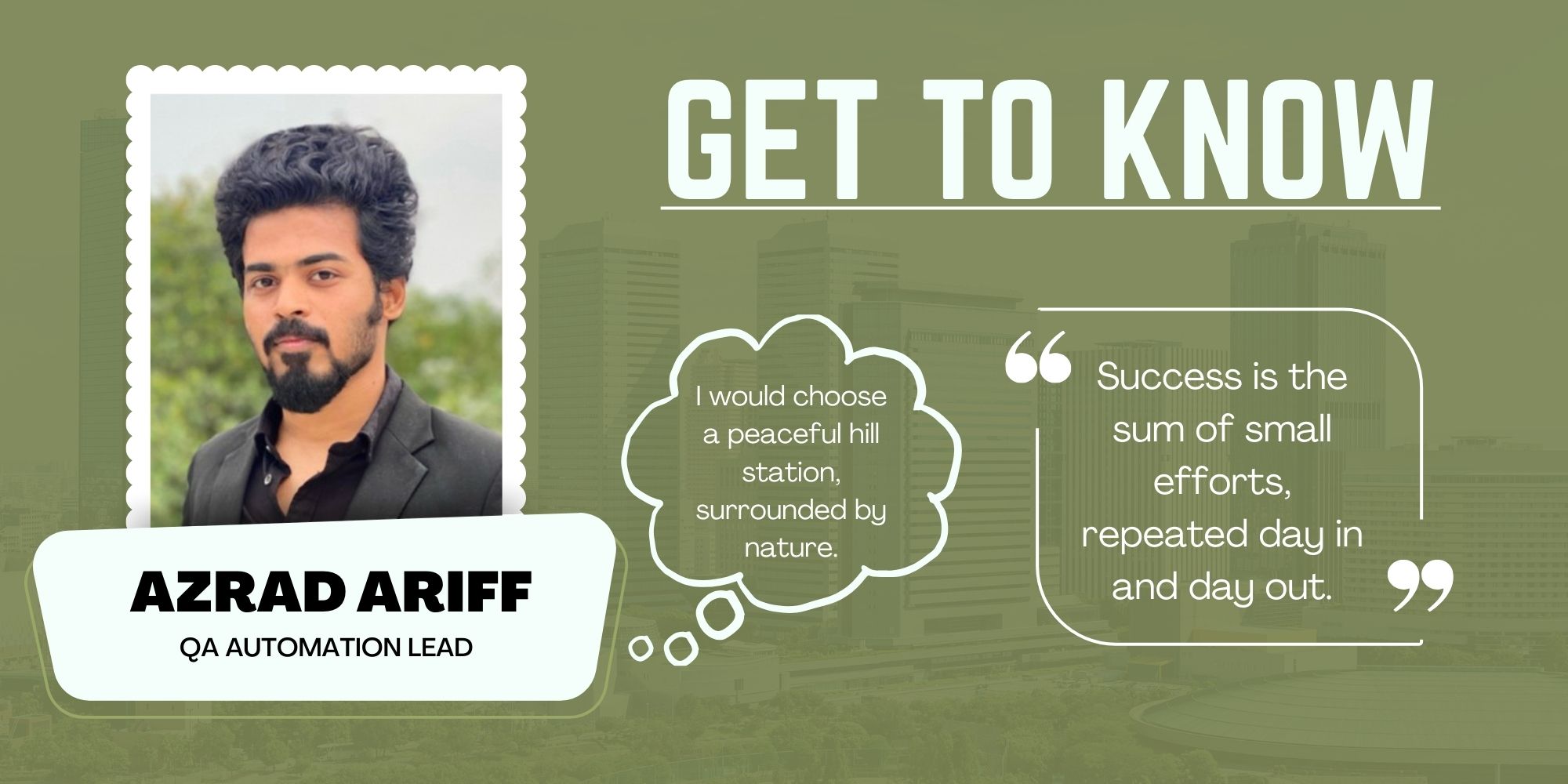About: Azrad Ariff is a QA Automation Lead at CloudQ, where he began in 2019 with a focus on manual testing before transitioning into automation. Skilled in tools like Selenium, Postman, and AutonomiQ, he now leads both manual and automation teams, ensuring high-quality delivery.
He holds a degree from Manonmaniam, Bharathiar University and has certifications in ISTQB, Copado, and AccelQ. Outside work, he enjoys building motorcycles—fueling his passion for problem-solving and hands-on learning.
1. Can you walk us through your journey into QA automation and what led you to become a QA Automation Lead?
I began my career in QA at CloudQ in 2019, initially focusing on manual testing and functional/regression testing. Over time, I developed an interest in automation, learning tools like Selenium, Postman, AccelQ, and AutonomiQ. I started automating complex workflows on platforms like Salesforce and Magento, leading to my promotion to Automation QA Lead in 2022. Since then, I’ve been managing both manual and automation teams, ensuring consistent quality delivery and continuous improvement.
2. What’s one area of automation testing that clients or teams often underestimate but plays a vital role in long-term product quality?
Test data management is often underestimated. While automation scripts are built, the importance of structured, reusable, and realistic test data is overlooked. Without it, even the best scripts can fail or produce inconsistent results. Proper management of test data ensures stability, reduces false positives/negatives, and supports effective edge case testing, ultimately leading to consistent quality.
3. As a QA Automation Lead, what do you find most rewarding about building and leading automation strategies for software projects?
What’s most rewarding is designing automation strategies that align with project complexity and business goals. For instance, in the CLEAResult project, I led both manual and automation teams, automating end-to-end workflows with tools like AutonomiQ and Selenium. Seeing the direct impact of automation—such as improved release cycle efficiency and reduced manual errors—drives my motivation. Mentoring my team and optimizing test execution to improve release quality is equally fulfilling.
4. How do you structure your mornings to maintain focus and drive when managing test automation efforts across teams or projects?
My mornings start with reviewing the previous day’s test executions to catch any failures or flaky tests. I prioritize tasks based on blockers, regression needs, or sprint deliverables, then check in with my team to align on goals and address roadblocks. This early focus on test planning and coordination ensures clarity for the team and maintains momentum across all projects.
5. When facing roadblocks in automation—whether flaky tests or CI/CD integration issues—do you lean more toward taking immediate action or analyzing before responding?
I prefer analyzing before responding. When issues arise, I review test results, including logs and failure messages, to pinpoint the root cause—whether it’s data-related, timing issues, or environment glitches. Understanding the issue allows me to fix the root cause rather than just addressing the symptoms, ensuring more sustainable and reliable automation.
6. If you could describe your approach to automation leadership in three words, what would they be?
- Strategic
- Collaborative
- Scalable
7. Could you share a story about a challenging automation project and how your leadership ensured the project stayed on track and met all quality goals?
A challenging project I led was with CLEAResult, testing complex workflows across Salesforce, Magento, and a mobile field tool. My role involved leading 24 team members in both manual and automated testing. Initially, adoption of AutonomiQ was slow, but I provided hands-on training and delegated tasks based on individual strengths. Regular sync-ups with stakeholders and developers helped resolve issues quickly. Despite the challenges, we delivered a robust automation suite that improved release cycle efficiency and ensured high-quality deliverables.
8. What part of your role as QA Automation Lead consistently energizes or inspires you?
What energizes me is transforming complex manual processes into efficient, automated workflows. I find inspiration in solving challenges, mentoring my team, and witnessing how our automation directly contributes to smooth releases and improved product quality.
9. Do you have a quote or guiding principle that helps you stay grounded during high-pressure sprints or tough debugging sessions?
“Success is the sum of small efforts, repeated day in and day out.” This quote reminds me that consistent, incremental progress leads to success, helping me stay focused during debugging or intense sprints.
10. If you could lead an automation team from anywhere in the world, where would it be and why?
I would choose a peaceful hill station, surrounded by nature. The calm environment fosters creativity and clarity, essential for solving complex automation problems. With today’s remote tools, I can still lead my team effectively from anywhere.
11. Outside of work, is there a skill or passion that positively influences the way you lead and build automation solutions?
Repairing and building motorcycles from scratch has honed my problem-solving and troubleshooting skills, which I apply to my automation work.
12. What’s your favorite way to recognize a major automation success or team achievement?
I like celebrating as a team and giving credit where it’s due. Whether it’s a successful UAT phase or reducing testing time, I ensure individual contributions are recognized, either through team calls or simple shoutouts in reports. Recognition boosts team morale and encourages continuous improvement.
13. If you weren’t in QA automation, what other role in tech or leadership do you think you’d naturally excel at?
I’d excel as a Product Owner or Business Analyst. My ability to analyze complex workflows and collaborate with stakeholders positions me well for roles that bridge business and technical needs.
14. Who has had the most significant influence on your career, and what advice from them continues to shape your leadership approach?
A senior QA mentor taught me that “Quality is everyone’s responsibility.” This mindset shaped my approach to testing and leadership, emphasizing collaboration and understanding the business impact of every test.
15. Do you have any end-of-day habits or rituals that help you disconnect and reset after a day of leading test automation efforts?
At the end of each day, I review test execution summaries and plan for the next day. This brief reflection allows me to disconnect with a clear head and prepare for the challenges ahead.
16. What advice would you give someone aiming to grow from an automation engineer to a QA Automation Lead?
My advice is to focus beyond writing test scripts—think like a leader, understand project goals, timelines, and how automation fits into the larger delivery process. Building leadership skills is key to progressing in your career.
That’s a wrap on our chat with Azrad! We hope you enjoyed exploring his journey from manual tester to QA Automation Lead at CloudQ. A big thanks to Azrad for sharing his insights, leadership mindset, and commitment to quality-driven automation.
Want to discover more inspiring stories from the talented folks at CloudQ? Dive into our full Get to Know series—each spotlight offers a fresh perspective and a behind-the-scenes look at what makes our team thrive. Find them here. Thanks for joining us, and stay tuned for the next feature!




